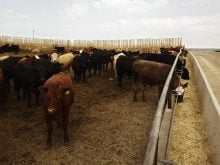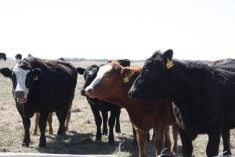This cattle market information is selected from the weekly report from Canfax, a division of the Canadian Cattlemen’s Association. More market information, analysis and statistics are available by becoming a Canfax subscriber by calling 403-275-5110 or at www.canfax.ca.
High price, low basis
The western Canadian fed market has been the tale of two stories. On the positive side, the fed market established new annual price highs. On the flip side, the market has been disappointing relative to the U.S. market because basis levels are weak. Fed prices have also been disappointing relative to feedlot breakeven as feeding margins continue to be negative.
Read Also

Chinese offer complicates canola marketing
Recently the Chinese ambassador indicated that there would be a potential deal between Canada and China regarding the current tariff war.
Competition on the cash market last week was limited with one packer buying most of the cattle. Dressed sales were reported at $304 per hundredweight delivered.
American packer interest was quiet and no cattle were marketed south. The Alberta fed cash-to-futures basis was reported at -$23.11 per cwt. For the start of November, this is the third weakest basis in history.
For the week ending Oct. 29, western Canadian steer carcass weights are record high, averaging 980 pounds. Western steer weights are 26 lb. heavier than eastern steer weights. With packers behind schedule in picking up contract cattle, and long pick-up times for cattle sold on the cash market, larger out-weights have resulted.
Packers are running five-day work weeks and have been reluctant to add additional Saturday shifts. Last week was the fourth week in a row that western Canadian fed slaughter has been below last year.
In Ontario, dressed sales were reported from $303-$306 per cwt. delivered, steady to $3 per cwt. higher than the previous week. Ontario fed prices have averaged in the low $180s per cwt. for the past 15 weeks.
In the United States, dressed sales in Iowa and Nebraska ranged from US$240-$243 per cwt., steady to $3 per cwt. higher than the previous week. Live sales in Nebraska were at $153 per cwt. while Texas and Kansas were at $150 per cwt., fully steady with the previous week.
For the week ending Oct. 22, U.S. beef cow slaughter totalled slightly more than 84,000 head, 11 percent larger than last year. This was the largest weekly beef cow slaughter since November 2011. Year-to-date beef cow slaughter is 13 percent higher than last year and year-to-date dairy cow slaughter is three percent lower than a year ago.
Cow prices ease
Non-fed cattle eased lower last week on ample offerings as buyers switch focus to fed middle meats for the holiday season. Slaughter cow prices were generally $3-$5 per cwt. lower than the previous week through auctions, and dressed bids slipped to around $178-$183 per cwt. delivered. D2s averaged $94.60 and D3s averaged $81.79 per cwt.
Butcher bull prices were the lowest since the first week of September, down $2.84 per cwt. from the previous week to average $124.70 per cwt. Non-fed prices are expected to test bottom in late November and should rebound modestly through December.
Feeder price dips
Alberta feeder prices dipped $2.25 per cwt. lower last week on a large offering and surging feed grain prices. Light steer and heifer calves weighing less than 400 lb. slipped sharply lower on limited offerings and varied quality.
Benchmark 500-600 lb. calves traded mixed with steer prices mostly steady. Similar weight heifers eased $1.50-$2 per cwt. lower. Big calves from 600-800 lb. traded unevenly lower with steers down $2.50-$3.50 per cwt. Good quality replacement calibre heifers saw a modest $1 per cwt. week-over-week decline.
Manitoba saw good demand from Ontario buyers and was the only province to see 600-800 lb. steer calf prices strengthen.
Alberta auction volumes were nine percent larger than the previous week and likely set an annual peak at slightly more than 100,000 head. Year-to-date auction volumes were four percent lower than a year ago at 1,341,401 head.
Canadian feeder exports to the U.S. for the week ending Oct. 22 rebounded from the previous week to 2,382 head but were 39 percent lower than the same week last year. Year-to-date feeder exports were 67 percent larger than a year ago, totalling 173,369 head.
Auction volumes have likely peaked, and offerings are expected to tighten.
U.S. cutouts strengthen
In U.S. beef trade, Choice cutouts ended last week up one percent from the previous week to US$265.18 per cwt. Select cutouts were steady with last week at $233.06 per cwt. Both Choice and Select cut-out values are stronger than the five-year average.














